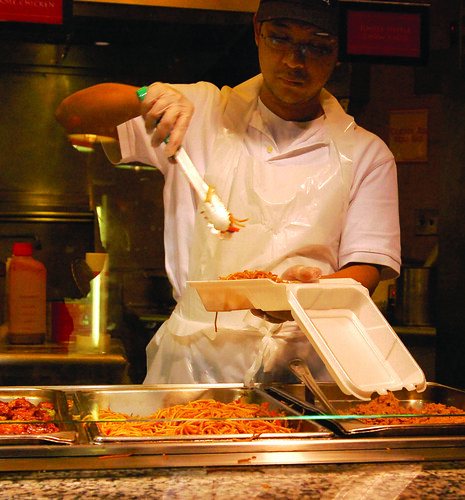
Environmental organizations on campus and the Office of Sustainability are making strides to make Temple an environmentally friendly campus, but the abundant presence of Styrofoam is one flaw they have yet to combat.
From Maxi’s on Liacouras Walk to the Mein Bowl in the Valaida S. Walker Dining Court, Styrofoam is still being used.
Even the Sexy Green Truck, which touts its environmental friendliness to customers, often uses Styrofoam containers to hold the food it sells.
Students for Responsible Business President Ben Schneible said Styrofoam is cost-effective, and as a result of its being cheaper than environmentally friendly products that might be triple the cost, it is typically sought after.
SRB and Students for Environmental Action recommend students wishing to help end Styrofoam usage at Temple be supportive.
Sodexo removed Styrofoam cups from the Johnson & Hardwick cafeteria at the beginning of the fall semester, but Styrofoam containers are still used at the food court in the Student Center.
“Most of the stuff we do that might have to do with [preventing Styrofoam use] is usually just awareness — reduce, reuse, recycle,” said Jessica Gruber, a senior environmental studies major and president of SEA. “Reduce how much you consume and how much you use, and if you can’t reduce it, you should reuse what you can so you’re not wasting it just once. And if you don’t need it anymore or can’t use it again, then you should recycle it.”
“As it pertains to Styrofoam use at Johnson & Hardwick, we eliminated it and are no longer using Styrofoam cups there,” said Jeffrey Browne, marketing director of Sodexo.
Styrofoam, a trademark of the Dow Chemical Company, is extruded polystyrene foam used for thermal insulation and for craft applications. It is also used for building materials such as pipe insulation and sheathing.
Expanded polystyrene beads compose the Styrofoam products and materials that are used for coffee cups, coolers and other packaging materials. Styrofoam is resistant to photolysis, a breaking down of material by sunlight. It is also non-biodegradable, which is why student environmentalists on campus are against use of the material.
“We’ve eliminated Styrofoam in the food court as well. I believe it’s very minimal there. We’re using recycled cardboard containers for a lot of our food products,” Browne said.
Sodexo has to deal with authentic international companies separately, he said, and it is contracted to change its Styrofoam usage next semester but can’t confirm the timeframe. He said if Sodexo does change it, the company will use something more sustainable.
“It’s not biodegradable, and it’s just going to be thrown away. A lot of that stuff is going to end up in landfills,” SEA Vice President Danny Doherty said.
“[Styrofoam] isn’t necessarily the heaviest thing in the world, so it’s going to blow out of those landfills,” said Doherty, a junior secondary education social studies major. “The real problem is animals confuse it for food, and it’s not edible. It’s not good for them because it’s toxic.”
Leigh-Golding DeSantis, a graduate extern in the Office of Sustainability, said the problem with Styrofoam is its long-term harm.
“Styrofoam, as with plastic, is made from oil, and we want to eventually get off oil because it is not a renewable resource,” DeSantis said. “That’s why in the long run, we don’t want to be using Styrofoam. Any decisions we make now, we’re looking at the impacts they’re going to have in the future.”
Schneible, a junior international business major, said the Sexy Green Truck used to use Styrofoam, but the truck owners recently found a substitute.
“They used it for the platters because they couldn’t find an alternative product, so they said they’d cut it out,” he said. “They found another product that’s a plastic product, which is still not great.”
Gruber and Doherty suggest people bring their own containers to the food court or places like Dunkin’ Donuts to help reduce Styrofoam usage.
“The only real solution is for people to bring their own cups or glass bottles or bring reusable mugs to a place like Dunkin’ Donuts, which uses Styrofoam for medium and large cups,” said Gruber, who added using reusable mugs at Dunkin’ Donuts gets customers 25 cents off a coffee purchase.
“We’re trying to help [independent business owners] improve or increase their business so that we can prove to them that people don’t want Styrofoam,” Schneible said. “It takes a commitment from our end to promote them, as well as the people that we’re promoting to the student body.”
He said this is the reason behind the Green Foods Initiative, a marketing campaign aimed at improving efficiency, reducing waste and helping trucks on campus find local produce. Each truck gets a certain amount of points for environmentally friendly deeds such as not using Styrofoam or installing solar panels. Each point is worth a quarter of a peach and the more peaches a truck has, the better rating for the truck.
“We’re trying to encourage them and the market,” Schneible said, “which is sort of the benefit in exchange for helping improve general practices on campus.”
Joshua Fernandez can be reached at josh@temple.edu.



Be the first to comment